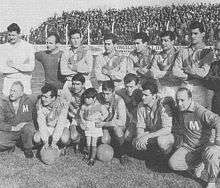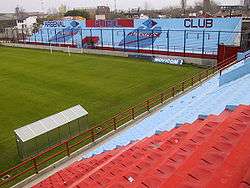Arsenal de Sarandí
 | |||
| Full name | Arsenal Fútbol Club | ||
|---|---|---|---|
| Nickname(s) |
Los del Viaducto (The Viaduct men) El Arse (The Arse) | ||
| Founded | 11 January 1957 | ||
| Ground |
Estadio Julio H. Grondona, Sarandí, Avellaneda Partido | ||
| Capacity | 18,500 | ||
| Chairman | Julio Ricardo Grondona | ||
| Manager | Humberto Grondona | ||
| League | Primera División | ||
| 2016–17 | 27th | ||
| Website | Club website | ||
|
| |||
Arsenal Fútbol Club (Spanish pronunciation: [arˈsenal ˈfutβol ˈkluβ]), usually referred as Arsenal de Sarandí [arˈsenal de saɾanˈdi], is an Argentine sports club from the Sarandí district of Avellaneda Partido, Greater Buenos Aires.
The football team currently plays in Primera División, the top division of the Argentine football league system. The squad plays its home games at the Estadio Julio H. Grondona, named after one of the founders, which has a capacity of 16,000. It opened in 1964 but was not used in the First Division until 2004. The club's colours are red and light blue, in honour of the traditional teams of Avellaneda (Independiente and Racing). Arsenal won its first Primera División championship in 2012. Until then, club's major title had been the Copa Sudamericana won in 2007.
Apart from football, the club hosts other sports such as handball and field hockey.
History

The beginning
The club was founded in January 1957 by brothers Héctor and Julio Humberto Grondona. The club were founded near to where the country's military arsenal was housed, which inspired the name. The team's shirt colour is light blue with a diagonal red band (similar to the shirt used by River Plate). The colours were chosen as a combination of the two older clubs in Avellaneda – Racing (light blue) and Independiente (red).

Julio Grondona went on to become president of Independiente, and then, in 1979, president of the Argentine Football Association, until 2014. He was also a vice-president of FIFA. Héctor Grondona, and then son Julio Ricardo, became presidents of Arsenal.
The club's best known former player is Jorge Burruchaga, who started his career at Arsenal in 1979, and had several stints as coach. Burru, as he is nicknamed, scored the winning goal for Argentina in the 1986 FIFA World Cup final against Germany.
Arsenal's football team was promoted to successively higher divisions in 1962, 1986 and 1992, finally reaching the Primera División in 2002.
On 6 September 2006, Arsenal and Spanish club FC Barcelona (Barça) struck a deal whereby in exchange for the option to acquire young players that have not played more than one year in the Arsenal first team, Barça would help to improve Arsenal's infrastructure.[1]
A member from Barça was to oversee the project, and visit the club on a monthly basis.[1] This deal, however, fell through in 2007, reportedly because Arsenal could not afford the infrastructure to keep up with the plan.
International tournaments
The club's first appearance in an international tournament was in 2004, when, coached by Burruchaga, Arsenal reached the Quarter-finals of the Copa Sudamericana, eliminating Banfield and River Plate before losing to Bolivian club, Bolívar in its first ever official tie with a non-Argentine team.
Arsenal finished 5th in both the Apertura and Clausura of the 2006–07 season, which gave it enough points to claim a place in the Copa Libertadores 2008, the first time in their history that Arsenal qualified for South America's premier club tournament. The team also qualified for the Copa Sudamericana 2007. Arsenal beat reigning Argentine champions San Lorenzo in the qualifying round to earn a place in the Round of 16 where it faced Brazilian team Goiás. Arsenal won 3–2 in Brazil and recorded a 1–1 draw in the second leg to win the tie 4–3 on aggregate, achieving its first official victory over foreign opposition.
After the victory over the Brazilian team, Arsenal met Mexican side Guadalajara in the quarter-finals, with a 0–0 draw at home, and a 3–1 victory at Estadio Jalisco. Arsenal qualified for the semi-finals, where they met the other Argentine team in the running, River Plate. Both games against River ended 0–0, Arsenal progressing to the final after winning the penalty shootout 4–2, with a number of saves from Mario Cuenca, Arsenal's goalkeeper.
In the first leg of the final Arsenal beat Club América of Mexico 3–2 at Estadio Azteca, giving it a good advantage for the 2nd leg. This advantage was mitigated by the fact that second match could not be held in the Estadio Julio H. Grondona stadium because its capacity of 16,300 did not meet the CONMEBOL criteria of 40,000 for major finals. The game was finally held at the Estadio Juan Domingo Perón in Avellaneda. Another mitigating factor was the fact that captain Carlos Castiglione was suspended for the last game, due to a red card in the first leg.
Arsenal needed to avoid defeat by a two-goal margin, but the match started badly for the Argentine team when Christian Díaz scored an own goal inside the first 20 minutes. José Luis Calderón then hit the woodwork twice for Arsenal. In the 2nd half Arsenal conceded a second goal, but with only 7 minutes remaining Martín Andrizzi scored a famous goal to give Arsenal their first major title on the away goals rule.
On 30 July 2008, Arsenal won its second international cup, the Suruga Bank Championship, which earned to play as Copa Sudamericana champion. The rival was J. League Cup champions Gamba Osaka from Japan. After a hard match, captain Carlos Casteglione scored the only goal with a precise header on the 86th minute of play.
First domestic titles
Arsenal won its first championship on 24 June 2012 after defeating Belgrano de Córdoba 1–0 with a goal scored by Lisandro López.[2] The squad totalized 38 points over 19 games played, with 11 matches won and only 3 defeats.[3] Arsenal also became the first team to win a Primera División title after playing in the five divisions that Argentine football league system is made of.[4] As champions, Arsenal classified for the Supercopa Argentina, a one-match tournament between the Primera División and the Copa Argentina winners. On 7 November 2012 Arsenal defeated Copa Argentina champions Boca Juniors 4–3 by penalties after a 0–0 draw.[5]
Arsenal won the Copa Argentina on 16 October 2013 by defeating San Lorenzo de Almagro 3–0 in a final match played at the Catamarca Province[6]
Stadium

The Estadio Julio H. Grondona in Sarandí has a capacity of 36,300, and is known as el Viaducto (The Viaduct). It is located at 3660 Juan Díaz De Solís in Sarandí.
Arsenal's first stadium was started to be built on 11 October 1962, officially opening on 22 August 1964. When Arsenal won promotion to the Primera, its basic concrete stadium was deemed unfit for the league and the team played at the grounds of Lanús and Racing for two seasons until work on the stadium was complete. The remodeled stadium (named "Julio Humberto Grondona") was opened on 7 August 2004 with a party for the fans. The first game was against Banfield in the Copa Sudamericana. The new stadium has witnessed defeats of the biggest teams in Argentine football such as Boca Juniors and River Plate.
Players
Current squad
- As of 6 August 2017.[7]
Note: Flags indicate national team as defined under FIFA eligibility rules. Players may hold more than one non-FIFA nationality.
|
|
Former coaches
|
|
Honours
Domestic
League
- Primera División (1): 2012 Clausura
- Primera C (1): 1964
- Primera D (1): 1962
National cups
- Copa Argentina (1): 2012–13
- Supercopa Argentina (1): 2012
International
- Copa Sudamericana (1): 2007
- Suruga Bank Championship (1): 2008
References
- 1 2 "El Arselona F.C.". Olé. 5 September 2006. Retrieved 2007-01-15. (in Spanish)
- ↑ "Arsenal es campeón por primera vez en su historia", Clarín, 24 June 2012
- ↑ "Primera División de Argentina, tabla final Clausura 2012", ESPN, 24 June 2012
- ↑ "Histórica coronación de Arsenal", Perfil, 24 June 2012
- ↑ "Arsenal amargó a Boca en los penales y se quedó con la Copa" Clarín, 7 November 2012 (in Spanish)
- ↑ "...Arse de risa" Olé, 17 October 2013 (in Spanish)
- ↑ "Arsenal de Sarandí squad". Soccerway. 6 August 2017. Retrieved 4 August 2017.
External links
| Wikimedia Commons has media related to Arsenal de Sarandí. |